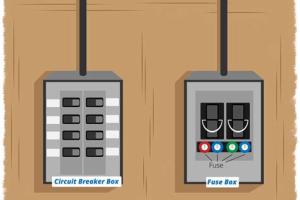Discovering Your Home's Power Source: A Comprehensive Guide to Finding the Fuse Box or Circuit Breaker Box

-
Quick Links:
- Introduction
- Understanding Fuse Boxes and Circuit Breakers
- Why You Should Find the Fuse Box
- Common Locations of Fuse Boxes
- Step-by-Step Guide to Finding Your Fuse Box
- Dealing with Difficult Situations
- Safety Tips When Working with Fuse Boxes
- Case Studies
- Expert Insights
- FAQs
Introduction
Finding your home’s fuse box or circuit breaker box is essential for electrical maintenance and safety. Whether you are troubleshooting an electrical issue, making upgrades, or ensuring your home is safe, knowing where to locate these critical components of your electrical system is vital. This guide will walk you through everything you need to know about finding and understanding your fuse box and circuit breaker box.Understanding Fuse Boxes and Circuit Breakers
Fuse boxes and circuit breakers are integral components of any home's electrical system.What is a Fuse Box?
A fuse box is an electrical panel that houses fuses, which are safety devices that protect circuits by breaking the connection if there’s an overload.What is a Circuit Breaker Box?
A circuit breaker box serves the same purpose as a fuse box but uses circuit breakers instead of fuses. Circuit breakers can be reset after they trip, making them more convenient than fuses.Why You Should Find the Fuse Box
Locating your fuse box is crucial for several reasons: - **Safety**: In emergencies, knowing where to cut off power can prevent accidents. - **Troubleshooting**: Issues with electrical appliances often require you to reset or replace fuses or breakers. - **Home Inspections**: If you’re selling your home, having this information readily available can help.Common Locations of Fuse Boxes
Fuse boxes and circuit breaker boxes are often located in specific areas of the home: - **Basements**: A common place for older systems. - **Garages**: Often found near the main entrance for easy access. - **Utility Rooms**: Sometimes located in dedicated utility spaces. - **Crawl Spaces**: Less accessible but may house older fuse boxes.Step-by-Step Guide to Finding Your Fuse Box
Follow these steps to locate your fuse box effectively:Step 1: Inspect Common Areas
Start by checking the common locations mentioned above.Step 2: Look for Labels
Many fuse boxes will have labels indicating their location, often found near electrical outlets.Step 3: Check Your Home’s Blueprints
If you have access to your home’s blueprints or electrical plans, these can provide specific details on where the fuse box is located.Step 4: Consult with a Professional
If you’re having trouble, consider consulting an electrician who can help locate your fuse box.Dealing with Difficult Situations
Sometimes, locating your fuse box can be more challenging than expected.Older Homes
In older homes, fuse boxes may be hidden behind panels or in less accessible areas. Searching through storage areas may be necessary.Newer Homes
In newer constructions, circuit breaker boxes are typically more accessible but may still be hidden.Safety Tips When Working with Fuse Boxes
Safety should always be your priority: - **Always Turn Off Power**: Before working on or near your fuse box, ensure the power is turned off. - **Use Insulated Tools**: This helps prevent electrical shock. - **Wear Protective Gear**: Safety glasses and gloves can protect you from accidental injuries.Case Studies
Let’s look at some real-world examples of how finding the fuse box helped homeowners: - **Case Study 1: The Overloaded Circuit**: A family faced frequent outages due to an overloaded circuit. By locating their fuse box, they were able to redistribute loads and fix the issue. - **Case Study 2: Home Renovation**: During a home renovation, the homeowner found their circuit breaker box in an unusual location, which led to a safer remodeling process.Expert Insights
We consulted with several electricians and home inspectors to gather their insights on the significance of fuse boxes and circuit breakers. Many emphasized the importance of regular checks and understanding how your home’s electrical system works.FAQs
- 1. What is the difference between a fuse box and a circuit breaker?
- A fuse box contains fuses that need to be replaced, while a circuit breaker can be reset after tripping.
- 2. How often should I check my fuse box?
- It’s good practice to check your fuse box annually for any signs of wear or issues.
- 3. Can I replace a fuse myself?
- Yes, but ensure you turn off the power first and use the correct type of fuse.
- 4. What should I do if my fuse keeps blowing?
- Identify the cause of the overload; it may indicate a serious electrical issue that requires professional help.
- 5. Where can I find my circuit breaker box?
- Common locations include basements, garages, and utility rooms.
- 6. Is it safe to reset a tripped breaker?
- Yes, but only if you have addressed the underlying issue that caused it to trip.
- 7. What tools do I need to work on my fuse box?
- You’ll need insulated tools, a flashlight, and possibly a voltage tester.
- 8. Can I upgrade my fuse box to a circuit breaker?
- Yes, consult a licensed electrician for the best options for your home.
- 9. What are the signs that my fuse box needs replacement?
- Signs include frequent blown fuses, rust, or burning smells.
- 10. How can I ensure my fuse box is safe?
- Regular inspections, keeping the area dry, and ensuring proper ventilation are key.
Random Reads
- How to open tmp files
- How to open torrent file
- Unlocking mac apps
- Unlocking hidden files searching windows 7
- How to install google chrome using terminal on linux
- How to install java games
- How to delete gmail account app
- How to determine if you have hard water
- Google gravity trick
- Go underwater google maps google earth